Abstract
Accurate streamflow simulation is crucial for many applications, such as optimal reservoir operation and irrigation. Conceptual techniques employ physical ideas and are suitable for representing the physics of the hydrologic model, but they might fail in competition with their more advanced counterparts. In contrast, deep learning (DL) approaches provide a great computational capability for streamflow simulation, but they rely on data characteristics and the physics of the issue cannot be fully understood. To overcome these limitations, the current study provided a novel framework based on a combination of conceptual and DL techniques for enhancing the accuracy of streamflow simulation in a snow-covered basin. In this regard, the current study simulated daily streamflow in the Kalixälven river basin in northern Sweden by integrating a snow-based conceptual hydrological model (MISD) with a DL model. Daily precipitation, air temperature (average, minimum, and maximum), dew point temperature, evapotranspiration, relative humidity, sunshine duration, global solar radiation, and atmospheric pressure data were used as inputs for the DL model to examine the effect of each meteorological variable on the streamflow simulation. Results proved that adding meteorological variables to the conceptual hydrological model underframe of parallel settings can improve the accuracy of streamflow simulating by the DL model. The MISD model simulated streamflow had an MAE = 8.33 (cms), r = 0.88, and NSE = 0.77 for the validation phase. The proposed deep-conceptual learning-based framework also performed better than the standalone MISD model; the DL method had an MAE = 7.89 (cms), r = 0.90, and NSE = 0.80 for the validation phase when meteorological variables and MISD results were combined as inputs for the DL model. The integrated rainfall-runoff model proposed in this research is a new concept in rainfall-runoff modeling which can be used for accurate streamflow simulations.
1. Introduction
Rainfall-runoff simulation is one of the core approaches in hydrology. However, there has been a struggle to thoroughly understand the link between rainfall and runoff because of the intricate interactions between land use, soil properties, and precipitation patterns [1,2,3,4]. Hydrological processes can be captured using physical-based or data-driven simulation models. Physically based models need much time and effort to comprehend the water cycle thoroughly. Additionally, these models need soil profiles of the study sites, which are impossible to obtain using the available survey and remote sensing methods. In contrast, data-driven approaches are frequently more adaptable and accurate [5]. Artificial neural network (ANN) algorithms have been effectively used as a data-driven model in various hydrological domains, including rainfall-runoff modeling, flood prediction, and climate change forecasting. These highly nonlinear, nonstationary, time-dependent, and geographically dispersed hydrological processes might result in significant modeling complexity [6,7,8].
The simulation and prediction of rainfall-runoff have been effectively implemented using a variety of ANN designs. However, some challenges still compromise model accuracy, such as choosing the best neural network parameters and the overfitting issue. As a result, adjusting these parameters significantly impacts the functionality of ANN predictions [9]. Most of the studies apply a feedforward neural network that could miss out on the unique characteristics of the data. In addition, the network requires temporal information in the input data to simulate time-series data. In this regard, a recurrent neural network (RNN), including the Elman and Jordan network, was developed to address this issue and boost speed and memory capacity. However, bursting and disappearing gradient issues plague these models. To address these shortcomings, Hochreiter and Schmidhuber [10] proposed long short-term memory (LSTM) as a deep learning (DL) model to offer insightful solutions for challenging problems, including language processing, handwriting recognition, and picture captioning. Multiple gates with various functionalities can be used in the LSTM architecture to regulate neurons and store data. Relevant data can be stored for a longer time in LSTM memory cells to analyze or anticipate a complicated dynamic sequence with reasonable accuracy [11].
Some of the previous research studies were examined to review the adopted techniques in modeling the rainfall-runoff process. For instance, Adnan et al. [12] estimated the hourly rainfall-runoff in the Italian Samoggia River basin using four machine learning techniques; multivariate adaptive regression splines (MARS), M5Tree, adaptive neuro-fuzzy inference system (ANFIS) coupled with fuzzy c-means (FCM) and particle swarm optimization (PSO), and multi-model simple averaging (MM-SA) ensemble approach. The outcomes of the developed models are assessed against the theoretical EBA4SUB model. Five statistics, including mean absolute error, root mean squared error (RMSE), Nash–Sutcliffe efficiency (NSE), scatter index, and modified index of agreement, are used to assess the effectiveness of the models. The MARS, ANFIS-FCM, and ANFIS-PSO models behaved similarly in terms of accuracy and provided better performance than the M5Tree model. For the MARS, ANFIS-FCM, ANFIS-PSO, and M5Tree models, RMSE is improved by 7.4%, 5%, 8.5%, and 28.8%, respectively, using the MM-SA model. The machine learning approaches often outperformed the EBA4SUB; however, the latter method offered higher accuracy in some instances than the M5Tree and MARS.
Shishegar et al. [13] predicted runoff rates by developing an octonion-valued neural network (OVNN). The model was evaluated using a rainfall time series in a Canadian watershed. According to the results, the OVNN was associated with less space complexity and more accurate results than a real-valued neural network, illustrating its effectiveness for real-time applications. Yokoo et al. [14] evaluated three DL techniques, namely RNN, gated recurrent unit (GRU), and LSTM for modeling rainfall-runoff in a snowy watershed. Additionally, the hyperparameter settings largely impacted the accuracy of models, and their optimal combinations were determined to maximize the performance and accuracy of the developed models. The findings indicated the high accuracy provided by GRU in most varieties. Shao et al. [15] modeled the runoff in the Linyi watershed using a nonlinear autoregressive model with exogenous input (NARX). The NSE, RMSE, correlation coefficient, and mean relative bias statistical indices showed the effectiveness of the NARX model in simulating the rainfall-runoff dynamic process while underestimating the peak flow. However, NARX based on runoff classification reduced underestimation and produced good simulation results. It was reported that this promising approach could serve as a benchmark for the existing rainfall and runoff models.
Van et al. [16] estimated rainfall-runoff in two hydro-meteorological stations in the Vietnamese Mekong Delta using a deep convolutional neural network (CNN) model. Two convolutional filters were simultaneously applied, enabling quick data processing and the utilization of the correlation between the multivariate time series. Conventional and LSTM models were used to compare the outcomes of the suggested model. The findings reported outperformance by the CNN and LSTM models compared with the traditional models, with the CNN model marginally outperforming the LSTM results statistically. Therefore, it can be concluded that the convolutional network is a time-efficient and straightforward alternative to linear and recurrent networks. It is suitable for regression-type problems and can effectively learn dependencies in and between the series without needing a long historical time series.
A robust model of the intricate process by which rainfall transforms into the runoff is the driving force behind this research study. There is currently a shortage of research on rainfall-runoff with deep architectures because these models are usually applied in classification problems. A few modern studies [17,18] provide the concept of hybrid rainfall-runoff models and have reported the superiority of hybrid models over traditional ones. To the best of our knowledge, no study has been reported yet which integrates advanced DL technique with conceptual rainfall-runoff models. Therefore, the research objectives of this research are to develop a unique framework for improving the accuracy of streamflow modeling in a snow-covered basin based on an integration of conceptual and DL approaches. The current study simulates daily streamflow in the Kalixälven river basin in northern Sweden by fusing a DL model with a snow-based conceptual hydrological model (MISD). To investigate the impact of each meteorological variable on the streamflow simulation, daily precipitation, air temperature (average, minimum, and maximum), dew point temperature, evapotranspiration, relative humidity, sunshine duration, global solar radiation, and atmospheric pressure data are used as inputs for the DL model.
2. Study Area
The investigation considered the Kalixälven river basin in northern Sweden as a case study for the rainfall-runoff simulation task (Figure 1). The outlet of the studied basin is located at the coordinates 67.7445 (latitude) and 20.0199 (longitude). The drainage area of the Kalixälven river basin is 1472.5 km2, and the basin area is covered by snow on most days of the year. The Kalixälven river basin is a pristine and steeped basin with 10% of the watershed area above 700 m [19]. The average precipitation was reported as 1.44 mm per day during the studied period, which is obtained in a 465 m elevation zone. The Kalixälven river basin is a snow-covered basin with (approximately) 200 snowy days per year, which add to the complexity of hydrological modeling in this basin. The average temperature in this basin was reported as −0.48 °C during the studied period, which shows characteristics of a cold region. The average of dew point temperature, relative humidity, global solar radiation, and evapotranspiration were reported as −4.315 °C, 75.23%, 90.86 W/m2, and 1.29 mm per day, respectively.

Figure 1.
Location of the Kalixälven river basin in northern Sweden.
The mean, minimum, and maximum air temperatures (T, Tmin, and Tmax), dew point temperature (Tdew), precipitation (P), relative humidity (RH), evapotranspiration (ET), global solar radiation (GSR), sunshine duration (SSD), and atmospheric pressure (AP) datasets for the period January 1985–December 2021 were collected from the Swedish Meteorological and Hydrological Institute for a snow-covered basin in northern Sweden (Kalixälven river basin). The measured streamflow (Q) for the same period was obtained for the outlet of the Kalixälven river basin. The statistical characteristics of the used dataset are listed in Table 1, and the hydrograph of the measured precipitation and streamflow is shown in Figure 2. Additionally, Figure 3 shows percentiles and streamflow duration curves during the study period (1985–2021).

Table 1.
Statistical characteristics of atmospheric and streamflow data.
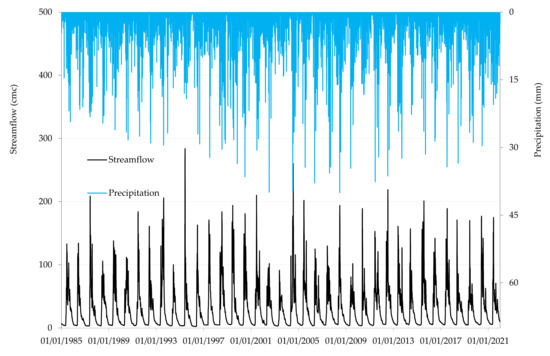
Figure 2.
Hydrograph of the measured streamflow vs. measured precipitation.
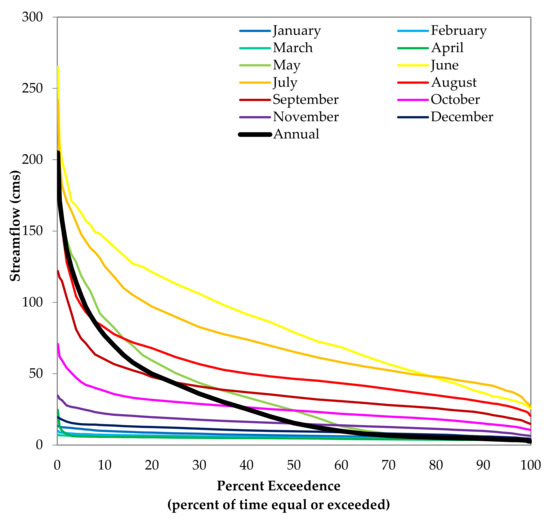
Figure 3.
Percentiles and streamflow duration curves for the study period (1985–2021).
3. Materials and Methods
The current study benefits from the advantages of a conceptual hydrological model and a DL approach under the framework of a hybrid DL-conceptual model for rainfall-runoff simulation. The proposed framework of the current study can be divided into two main levels: (i) the conceptual phase via the MISD model, and (ii) the DL phase for improving the accuracy of streamflow modeling in the snow-covered basin.
3.1. Conceptual Phase via MISD: Modello Idrologico Semi-Distribuito in Continuo
MISD as a conceptual hydrological model was applied for flood modeling in the Upper Tiber River (Italy) for the first time by Brocca et al. [20]. The MISD works based on the soil moisture module, which is proved to modify storage capacity and rainfall-runoff simulation correspondingly. The MISD uses air temperature (for calculating evapotranspiration) and precipitation data as input datasets for rainfall-runoff simulations at the basin scale. A linear function calculates evapotranspiration and water level at the first layer of soil, and infiltration from the soil surface to the root zone is considered by a nonlinear function [21]. There are three distinct components of surface runoff: the excess surface saturation, the second soil layer, and the subsurface runoff component, which all contribute to runoff production. The instantaneous geomorphological unit hydrograph is used to gather excess surface saturation, the second soil layer acts as streamflow at the basin outlet, and groundwater runoff is routed to the outlet using the linear reservoir approach [22]. The MISD model works based on eleven parameters, which should be calibrated by measured streamflow. To achieve this objective, the MISD model was calibrated using a trial-and-error method procedure based on the assessment metrics; and its calibrated parameters are summarized in Table 2.

Table 2.
Parameter setting of MISD model.
3.2. Deep Learning Phase
The current study used the group method of data handling (GMDH) as a DL model for combining the results of the MISD model with extra meteorological variables. GMDH is a type of polynomial neural network that was first introduced by Ivakhnenko [23]. The GMDH method works based on a self-organizing machine learning algorithm and it can be utilized to address complicated practical issues due to its self-optimization ability, which is strongly related to the input data [24]. Several neurons in each layer conduct the performance of GMDH that generates a new set of neurons in the subsequent layer based on some mathematical functions. The exiting neurons of each layer play a substantial part in developing some new neurons in the next layer [25]. This flexible technique can be optimized by coupling it with meta-heuristic algorithms to the optimal selection of new neurons in each layer and finding a more optimal solution. A polynomial function such as Equation (1) is a commonly used function for modeling a complex system (e.g., rainfall-runoff), including a set of input datasets (e.g., precipitation and temperature) and an output (e.g., runoff).
where refers to the input vectors , refers to the model output, and plays the role of a polynomial. Figure 4 shows components of the conceptual rainfall-runoff model, linking with GMDH, inputs, and output datasets of the current study.
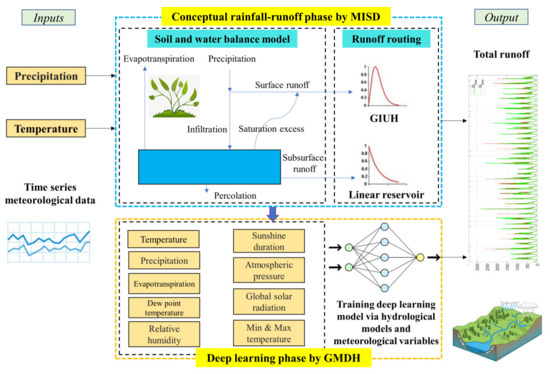
Figure 4.
Flowchart of the current study.
3.3. Performance Assessment
The dataset is divided into a calibration stage (from 1 January 1985 to 31 December 2012: 27 years) equal to 75% of the dataset, and a validation stage (from 1 January 2013 to 31 December 2021: 8 years) equal to 25% of the dataset for the implementation of conceptual and DL models. The calibration period was chosen as 1 January 1985 to 31 December 2012, and the validation period was selected as 1 January 2013 to 31 December 2021. For the assessment of streamflow simulation, the current study uses the mean absolute error (MAE), Pearson correlation coefficient (r), and the Nash–Sutcliffe efficiency (NSE), which are popular criteria for hydrological simulation performance assessment. Equations (2)–(4) are used for computing the evaluation criterion.
where and ( and ) represent modeled and measured streamflow, respectively, and N is the number of measured values used for calibrating and validating models, separately.
4. Results
4.1. Assessment of Conceptual Streamflow Simulation
Table 3 displays the outcomes of applying metrics to the conceptual hydrological model (MISD). Notably, the obtained values deviate from the used models, with the MISD exhibiting superior performance on average. The MISD model is associated with the most minor variation between the calibration and validation stages with an r of 0.03. Generally, the NSE and r findings describe the acceptable performance of the MISD model; during the calibration process, r and NSE were reported as equal to 0.85 and 0.69, respectively, and during the validation period, r and NSE were reported as equivalent to 0.88 and 0.77, respectively.

Table 3.
Outcomes of the applied metrics to the MISD model.
Figure 5 depicts a scatter plot of measured and simulated streamflow using a conceptual hydrological model (MISD) throughout its calibration and validation phases. It is shown that MISD catches the higher streamflow values with fewer discrepancies, and also that the MISD model demonstrated the same behavior during the calibration and validation stages. In addition, the small values (minimum values approximately less than 100 cms) of streamflow were predicted with high correlations. These values are close to the 1:1 line (yellow dashed line) in both the calibration and validation stages. In comparison, the large streamflow values (approximately more than 100 cms) are further away from line 1:1 in Figure 5. This issue reminds us that simulation of extreme values (particularly maximum events) is challenging for the MISD model in both calibration and validation stages.
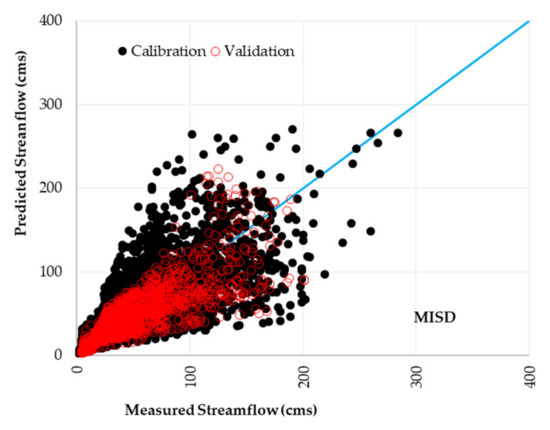
Figure 5.
Scatter plots of observed vs. simulated streamflow by the MISD model.
Figure 6 depicts the time series of observed streamflow and the modeled streamflow at the outlet of the basin by the MISD model. Calibration and validation steps were chosen based on time series objectives. The MISD model has acceptable performance and most of the extremum values in streamflow simulation were identified by the MISD model. However, the MISD model simulated minimum values better than maximum values during the calibration and validation periods. As can be seen in Figure 6, baseflow was detected and simulated very well and close to the measured streamflow. MISD faced a challenge for the peak flow simulation, particularly in 1991, 1994, 2006, and 2012 during the calibration phase, and in 2013, 2015, 2016, and 2020 during the validation phase.
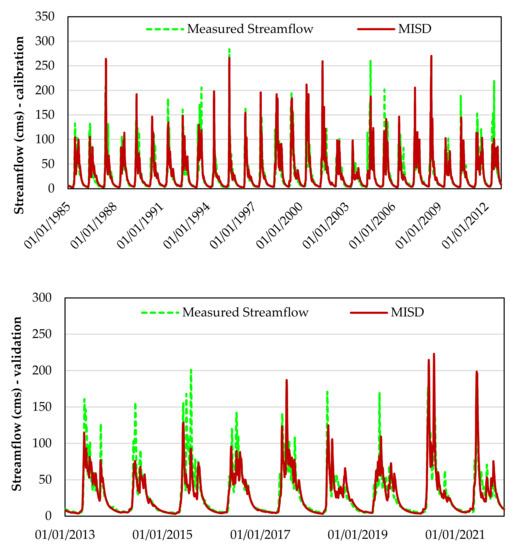
Figure 6.
Hydrograph of observed vs. modeled streamflow by MISD model.
4.2. Hybrid Phase Based on the Deep Conceptual Learning Framework
Since the applied metrics of the conceptual hydrological models did not provide excellent results, a DL model was chosen to increase the accuracy of the output obtained from the conceptual hydrological model. The numerous scenarios (described in Table 4) were presented by using the DL approach to the streamflow output acquired from the conceptual hydrological models in the preceding step in conjunction with various additional meteorological variables.

Table 4.
Scenarios for adding extra meteorological variables to the MISD model by DL.
According to Table 4, this study investigated the integration of the hydrological model’s output with each meteorological variable as input to the DL model. To achieve this aim, the simulated streamflow by MISD and precipitation were considered as inputs for the DL model (namely DL1); the simulated streamflow by MISD model, precipitation, (average) temperature, minimum temperature, maximum temperature, dew point temperature, evapotranspiration, global solar radiation, sunshine duration, relative humidity, and atmospheric pressure variables was considered as inputs for the DL model (namely DL10), and so on. According to the findings, adding meteorological variables improved the streamflow simulation for the conceptual hydrological model. The MISD model was enhanced by adding precipitation, air temperature (average, minimum, and maximum), dew point temperature, evapotranspiration, relative humidity, sunshine duration, and global solar radiation at the best scenario (DL9). In the testing phase, the ninth scenario (DL9) increased the capability of the MISD model to simulate streamflow by MAE = 7.89 (mcs), NSE = 0.80, and r = 0.90 (according to Table 5).

Table 5.
Outcomes of the applied metrics for various DL models throughout the calibration and validation stages.
Generally, adding precipitation, evapotranspiration, and any kind of temperature is more effective than other meteorological variables to enhance the performance of the conceptual hydrological model by the DL technique. Figure 7 illustrates the impact of adding extra meteorological factors to the MISD model on the observed and simulated streamflow during the training and testing stages. Figure 7 shows that adding extra meteorological variables to the DL model for simulating runoff can increase the accuracy of simulated runoff.
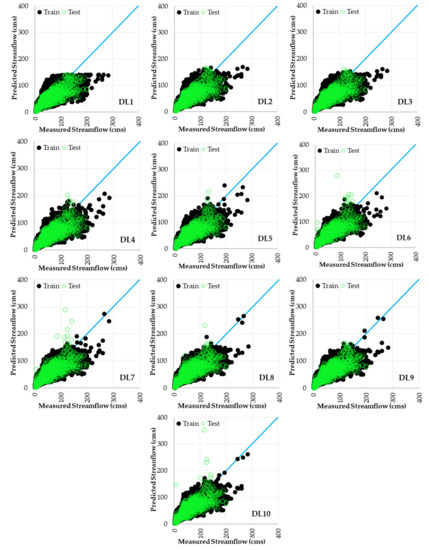
Figure 7.
Scatter plots of observed vs. modeled streamflow by DL1 to DL10 models.
Figure 8 depicts the observed and modeled hydrographs by the best scenarios, including the MISD model incorporating meteorological variables generated by the DL (DL9) model for the training and testing phases. Both the training and testing phases demonstrated that adding meteorological variables to the hydrological model in parallel may improve runoff modeling performance in the snow-covered catchment. However, DL9 differs in its capacity to incorporate meteorological data into the best-simulated hydrograph. As shown by the simulated hydrograph (Figure 8), DL9 can reproduce streamflow accurately in all seasons. In addition, DL9 is capable of incorporating additional meteorological data into the conceptual hydrological model. Comparing Table 3 and Table 5 also proves this improvement; Table 3 reported MAE = 8.33 cms, NSE = 0.77, and r = 0.88 for the validation phase of the MISD model, whereas Table 5 reported MAE = 7.89 cms, NSE = 0.80, and r = 0.90 for the testing section of DL9 model which proves the accurate runoff prediction via the proposed DL9 model.
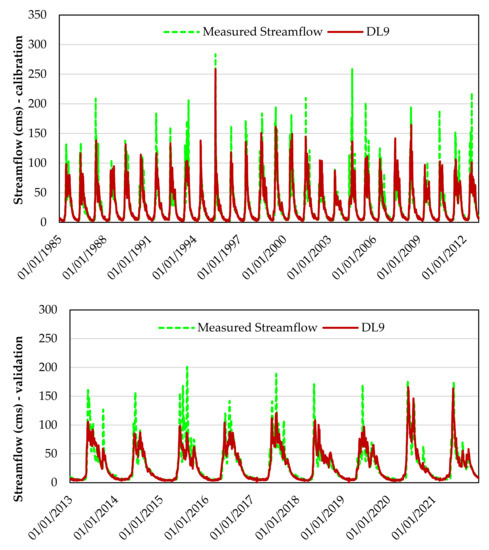
Figure 8.
Hydrograph of measured vs. simulated streamflow by DL9.
5. Discussion
Streamflow is one of the complex and nonlinear components of the hydrological cycle; the current study tries to apply a set of models (including conceptual-based and DL-based models) to overcome the complexity of streamflow in the snow-covered basin. The conceptual method (MISD) of considering streamflow mechanisms is beneficial for comprehending and simulating given the physical characteristics of the water cycle. Besides this, DL-based approaches have more computational capabilities to understand the non-linear relationships between meteorological variables and streamflow mechanisms.
Figure 9 shows the average amount of measured streamflow from January to May. The amount of streamflow decreases by a gentle slope each year, and there is a sudden increase between May and June of each year. The peak flow occurs between June and July of each year, and then streamflow decreases from July to December. This was the natural behavior of the Kalixälven river basin from 1985 to 2021, and during the streamflow simulation, the applied models tried to achieve this periodic behavior. As seen in Figure 9, the MISD model simulated the periodic behavior of streamflow well, and the MISD could detect extremum values of streamflow with acceptable accuracy. However, peak flow was detected well by the MISD model, but the model had some challenges and uncertainties in simulating runoff from July to November of each year. This issue can refer to the effect of snowmelt during the summer and early autumn of each year; especially during July and August, the MISD’s 25th–75th percentiles are less than the mean and median values of measured streamflow. Additionally, DL9 followed the natural streamflow behavior in the studied basin with fewer Min–Max ranges. The mean and median of simulated streamflow by the DL model are fitted by each other and these two lines had the same behavior. Additionally, the result of DL9 proved a flexible behavior against extremum values and its result is smoother than simulated streamflow by the MISD model.
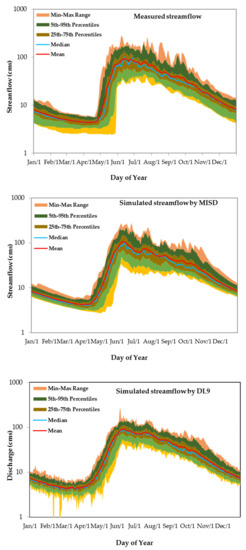
Figure 9.
Daily streamflow analysis on measured vs. simulated data.
The MISD model was applied to the Emme watershed (in Switzerland) by Mohammadi et al. [8], and they reported NSE and r for the validation phase of MISD as equal to 0.39 and 0.64, respectively. In contrast, the current study reported the same values as 0.77 and 0.88, respectively. The current proposed framework tries to reduce the amount of uncertainty in models’ inputs, by investigating the effect of each meteorological variable on streamflow modeling. In this way, each meteorological variable was added to the conceptual hydrological model (MISD) separately and the impact of each variable was analyzed in streamflow in Table 5. Considering the output of the MISD model with P, T, Tmax, Tmin, Tdew, ET, GSR, SSH, and RH was one of the best input structures, and the result proved adding these meteorological variables to the MISD model via DL approaches can improve streamflow simulation in the snow-covered basin.
Figure 10 shows cumulative streamflow analysis on measured streamflow and simulated streamflow by MISD and DL9 models. The minimum cumulative streamflow occurs from January to May of each year, and then streamflow increases suddenly from June to December. Since the studied basin is snow-covered, the reason for this could be snowmelt after June, and melted snow can be added to streamflow as freshwater from June to December. The MISD model simulated a pattern of daily cumulative close to the measured amount of streamflow. However, the MISD model considered a large area for the boundary of 75th–95th percentiles, which is far from the measured amount of streamflow. In addition, streamflow accumulation at the end of the year equals 1200 million cubic meters per second (mcms), whereas the MISD model simulated accumulation of streamflow at the end of the year as equal to 1400 mcms. The final result demonstrated that the proposed coupled approach could simulate streamflow in a snow-covered basin closely.
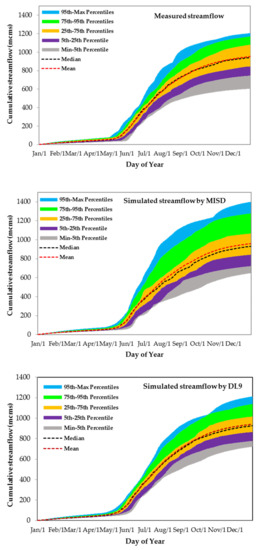
Figure 10.
Daily cumulative analysis on measured vs. simulated streamflow.
Several researchers have already reported the performance of different types of machine learning techniques for hydrological modeling [26,27,28,29,30,31,32,33,34,35], and also the performance of physically based hydrological models for runoff simulation [36,37,38,39]. Previous studies showed the excellent performance of MISD for runoff simulation in various regions. Masseroni et al. [21] used the MISD model for flood forecasting in Italy; they reported NSE = 0.87 to 0.95 for the validation phase, whereas the current study reported NSE = 0.77 for the validation phase. Rahman et al. [40] used soil and water assessment tool (SWAT) and multi-layer perceptron models for runoff simulation in the Upper Indus Basin. They reported NSE = 0.71 to 0.77 for the validation phase of the SWAT model. They also recommended the development of a hydrological model via machine learning models, which concurs with the current study. A Xin’anjiang model was used for hydrological modeling by Fang et al. [41]. They also reported the ability of machine learning for enhancing the performance of hydrological models, and the current study likewise recommends the use of machine learning models in parallel and series conditions for improving the ability of hydrological models [42,43]. In addition, the current study proposed a coupled approach based on DL and physically based models, and this finding concurs with that of Ditthakit et al. [44], who applied machine learning approaches for supporting the ability of a hydrological model (namely GR2M) in Thailand.
The artificial intelligence model which operates by finding and learning possible patterns in the meteorological dataset can be applied as an effective tool for hydrological time series analysis [45,46,47,48,49]. There are interactions between T, Tmin, Tmax, Tdew, P, RH, ET, GSR, SSD, AP, and daily runoff, and applying the DL model supports the MISD model in considering all these relationships and other possible relationships between datasets during runoff simulation. Various types of DL models were applied for runoff studies in different regions [50,51,52,53,54,55,56,57,58,59]. All of them reported the excellent ability of DL approaches to find the relationship between considered inputs and runoff time series. The GMDH, by finding and sorting different solutions and also due to its self-organizing approach, can find the relationship between each meteorological variable and runoff process, and was reported as an effective tool for rainfall-runoff simulation. In addition, the current study proposed a coupled model by using hydrological physically based models and DL models, and this finding is concurrent with several previous studies in which machine learning/DL models are applied to support hydrological models [7,8,35,60,61,62].
6. Conclusions
This study assessed a deep-conceptual learning-based framework’s capacity to simulate streamflow in a snow-covered basin. The proposed approach employed the benefits of MISD (as a conceptual hydrological model) and GMDH (as a DL approach) using the mean, minimum, and maximum air temperature, dew point temperature, precipitation, relative humidity, evapotranspiration, global solar radiation, sunshine duration, and atmospheric pressure dataset. The study led to the following conclusions:
- Adding meteorological variables as external elements to a conceptual hydrological model is highly effective and outperforms the ordinary MISD model in streamflow simulation.
- The GMDH enhanced the accuracy of MISD for runoff simulation tasks in a snow-covered basin; the best results achieved via DL9 structures by MAE, r, and NSE throughout the testing phase were 7.89, 0.90, and 0.80 in Kalixälven hydrometric station.
- All of the employed meteorological variables improved the accuracy of streamflow simulation, and generally, adding the mean, minimum, and maximum air temperature, dew point temperature, precipitation, relative humidity, evapotranspiration, global solar radiation, and sunshine duration simulated streamflow better than the other implemented scenarios.
The primary weakness of this research is its reliance on restricted data, which is dependent on the climate condition of the study area. To support the correctness of the suggested framework, additional data from diverse climatic locations are required to be analyzed by the proposed framework. Future research may also apply this framework to different types of climates and also use other potential machine learning/deep learning techniques. In addition, an evaluation of the ability of the global climate models as input datasets for hydrological and machine learning models is recommended. The proposed framework for runoff modeling in the current study can be applied for runoff modeling via various available meteorological variables in different regions; additionally, other types of data-driven approaches and optimization algorithms can be used in the structure of the current framework.
Author Contributions
Conceptualization, B.M., M.A., and Z.D.; methodology, B.M.; software, B.M.; validation, B.M., M.A., N.E., M.J., and Z.D.; formal analysis, B.M., M.A., and N.E.; investigation, M.A., N.E., and M.J.; data curation, B.M.; writing—original draft preparation, B.M., M.A., and N.E.; writing—review and editing, Q.B.P., B.M., M.A., N.E., M.J., and Z.D.; visualization, Q.B.P., M.A., and B.M.; supervision, Q.B.P., M.A., and Z.D. All authors have read and agreed to the published version of the manuscript.
Funding
This research received no external funding.
Institutional Review Board Statement
Not applicable.
Informed Consent Statement
Not applicable.
Data Availability Statement
Data will be available upon request.
Conflicts of Interest
The authors declare no conflict of interest.
References
- Berhane, S.; Zemadim, B.; Haile, D.; Melesse, A. Understanding runoff generation processes and rainfall runoff modelling in the Meja watershed of Ethiopia. NBDC Tech. Rep. 2013. Available online: https://hdl.handle.net/10568/34264 (accessed on 11 October 2022).
- Breinl, K.; Lun, D.; Müller-Thomy, H.; Blöschl, G. Understanding the relationship between rainfall and flood probabilities through combined intensity-duration-frequency analysis. J. Hydrol. 2021, 602, 126759. [Google Scholar] [CrossRef]
- Zhang, K.; Wang, S.; Bao, H.; Zhao, X. Characteristics and influencing factors of rainfall-induced landslide and debris flow hazards in Shaanxi Province, China. Nat. Hazards Earth Syst. Sci. 2019, 19, 93–105. [Google Scholar] [CrossRef]
- Gao, C.; Hao, M.; Chen, J.; Gu, C. Simulation and design of joint distribution of rainfall and tide level in Wuchengxiyu Region, China. Urban Clim. 2021, 40, 101005. [Google Scholar] [CrossRef]
- Parisouj, P.; Mokari, E.; Mohebzadeh, H.; Goharnejad, H.; Jun, C. Physics-informed data-driven model for predicting streamflows: A case study of the Voshmgir Basin, Iran. Appl. Sci. 2022, 12, 7464. [Google Scholar] [CrossRef]
- Kirchner, J. Characterizing nonlinear, nonstationary, and heterogeneous hydrological response using ensemble rainfall-runoff analysis. AGU Fall Meet. Abstr. 2021, 2021, H13E-07. [Google Scholar]
- Mohammadi, B.; Moazenzadeh, R.; Christian, K.; Duan, Z. Improving streamflow simulation by combining hydrological process-driven and artificial intelligence-based models. Environ. Sci. Pollut. Res. 2021, 28, 65752–65768. [Google Scholar] [CrossRef]
- Mohammadi, B.; Safari, M.J.S.; Vazifehkhah, S. IHACRES, GR4J and MISD-based multi conceptual-machine learning approach for rainfall-runoff modeling. Sci. Rep. 2022, 12, 12096. [Google Scholar] [CrossRef]
- Qi, M.; Zhang, G.P. An investigation of model selection criteria for neural network time series forecasting. Eur. J. Oper. Res. 2001, 132, 666–680. [Google Scholar] [CrossRef]
- Hochreiter, S.; Schmidhuber, J. Long short-term memory. Neural Comput. 1997, 9, 1735–1780. [Google Scholar] [CrossRef]
- Wu, X.; Liu, Z.; Yin, L.; Zheng, W.; Song, L.; Tian, J.; Yang, B.; Liu, S. A Haze Prediction Model in Chengdu Based on LSTM. Atmosphere 2021, 12, 1479. [Google Scholar] [CrossRef]
- Adnan, R.M.; Petroselli, A.; Heddam, S.; Santos, C.A.G.; Kisi, O. Short term rainfall-runoff modelling using several machine learning methods and a conceptual event-based model. Stoch. Environ. Res. Risk Assess. 2021, 35, 597–616. [Google Scholar] [CrossRef]
- Shishegar, S.; Ghorbani, R.; Saoud, L.S.; Duchesne, S.; Pelletier, G. Rainfall–runoff modelling using octonion-valued neural networks. Hydrol. Sci. J. 2021, 66, 1857–1865. [Google Scholar] [CrossRef]
- Yokoo, K.; Ishida, K.; Nagasato, T.; Ercan, A.; Tu, T. Comparison of three recurrent neural networks for rainfall-runoff modelling at a snow-dominated watershed. IOP Conf. Ser. Earth Environ. Sci. 2021, 851, 012012. [Google Scholar] [CrossRef]
- Shao, Y.; Zhao, J.; Xu, J.; Fu, A.; Li, M. Application of rainfall-runoff simulation based on the NARX dynamic neural network model. Water 2022, 14, 2082. [Google Scholar] [CrossRef]
- Van, S.P.; Le, H.M.; Thanh, D.V.; Dang, T.D.; Loc, H.H.; Anh, D.T. Deep learning convolutional neural network in rainfall–runoff modelling. J. Hydroinformatics 2020, 22, 541–561. [Google Scholar] [CrossRef]
- Yang, T.; Sun, F.; Gentine, P.; Liu, W.; Wang, H.; Yin, J.; Du, M.; Liu, C. Evaluation and machine learning improvement of global hydrological model-based flood simulations. Environ. Res. Lett. 2019, 14, 114027. [Google Scholar] [CrossRef]
- Konapala, G.; Kao, S.-C.; Painter, S.L.; Lu, D. Machine learning assisted hybrid models can improve streamflow simulation in diverse catchments across the conterminous US. Environ. Res. Lett. 2020, 15, 104022. [Google Scholar] [CrossRef]
- Sferratore, A.; Billen, G.; Garnier, J.; Smedberg, E.; Humborg, C.; Rahm, L. Modelling nutrient fluxes from sub-arctic basins: Comparison of pristine vs. dammed rivers. J. Mar. Syst. 2008, 73, 236–249. [Google Scholar] [CrossRef]
- Brocca, L.; Melone, F.; Moramarco, T. Distributed rainfall-runoff modelling for flood frequency estimation and flood forecasting. Hydrol. Process. 2011, 25, 2801–2813. [Google Scholar] [CrossRef]
- Masseroni, D.; Cislaghi, A.; Camici, S.; Massari, C.; Brocca, L. A reliable rainfall–runoff model for flood forecasting: Review and application to a semi-urbanized watershed at high flood risk in Italy. Hydrol. Res. 2017, 48, 726–740. [Google Scholar] [CrossRef]
- Brocca, L.; Melone, F.; Moramarco, T.; Singh, V.P. A continuous rainfall-runoff model as tool for the critical hydrological scenario assessment in natural channels. In From Headwater to the Ocean. Hydrological Changes and Managements; Taniguchi, M., Bur-nett, W.C., Fukushima, Y., Haigh, M., Umezawa, Y., Eds.; Taylor & Francis Group: London, UK, 2008; pp. 175–179. [Google Scholar]
- Ivakhnenko, A.G. Heuristic self-organization in problems of engineering cybernetics. Automatica 1970, 6, 207–219. [Google Scholar] [CrossRef]
- Teng, G.; Xiao, J.; He, Y.; Zheng, T.; He, C. Use of group method of data handling for transport energy demand modeling. Energy Sci. Eng. 2017, 5, 302–317. [Google Scholar] [CrossRef]
- Nariman-Zadeh, N.; Darvizeh, A.; Darvizeh, M.; Gharababaei, H. Modelling of explosive cutting process of plates using GMDH-type neural network and singular value decomposition. J. Mater. Process. Technol. 2002, 128, 80–87. [Google Scholar] [CrossRef]
- Choi, J.; Won, J.; Jang, S.; Kim, S. Learning Enhancement Method of Long Short-Term Memory Network and Its Applicability in Hydrological Time Series Prediction. Water 2022, 14, 2910. [Google Scholar] [CrossRef]
- Li, X.; Zhang, L.; Zeng, S.; Tang, Z.; Liu, L.; Zhang, Q.; Tang, Z.; Hua, X. Predicting Monthly Runoff of the Upper Yangtze River Based on Multiple Machine Learning Models. Sustainability 2022, 14, 11149. [Google Scholar] [CrossRef]
- Mohammadi, B. A Review on the Applications of Machine Learning for Runoff Modeling. Sustain. Water Resour. Manag. 2021, 7, 98. [Google Scholar] [CrossRef]
- Singh, A.K.; Kumar, P.; Ali, R.; Al-Ansari, N.; Vishwakarma, D.K.; Kushwaha, K.S.; Panda, K.C.; Sagar, A.; Mirzania, E.; Elbeltagi, A.; et al. An Integrated Statistical-Machine Learning Approach for Runoff Prediction. Sustainability 2022, 14, 8209. [Google Scholar] [CrossRef]
- Guan, Y.; Mohammadi, B.; Pham, Q.B.; Adarsh, S.; Balkhair, K.S.; Rahman, K.U.; Linh, N.T.T.; Tri, D.Q. A Novel Approach for Predicting Daily Pan Evaporation in the Coastal Regions of Iran Using Support Vector Regression Coupled with Krill Herd Algorithm Model. Theor. Appl. Climatol. 2020, 142, 349–367. [Google Scholar] [CrossRef]
- Li, P.; Zhang, J.; Krebs, P. Prediction of Flow Based on a CNN-LSTM Combined Deep Learning Approach. Water 2022, 14, 993. [Google Scholar] [CrossRef]
- Contreras, P.; Orellana-Alvear, J.; Muñoz, P.; Bendix, J.; Célleri, R. Influence of Random Forest Hyperparameterization on Short-Term Runoff Forecasting in an Andean Mountain Catchment. Atmosphere 2021, 12, 238. [Google Scholar] [CrossRef]
- Jung, K.; Kim, E.; Kang, B. Estimation of Low-Flow in South Korean River Basins Using a Canonical Correlation Analysis and Neural Network (CCA-NN) Based Regional Frequency Analysis. Atmosphere 2019, 10, 695. [Google Scholar] [CrossRef]
- Mehdizadeh, S.; Mohammadi, B.; Ahmadi, F. Establishing Coupled Models for Estimating Daily Dew Point Temperature Using Nature-Inspired Optimization Algorithms. Hydrology 2022, 9, 9. [Google Scholar] [CrossRef]
- Seo, Y.; Kim, S.; Singh, V. Machine Learning Models Coupled with Variational Mode Decomposition: A New Approach for Modeling Daily Rainfall-Runoff. Atmosphere 2018, 21qas, 251. [Google Scholar] [CrossRef]
- Ávila, L.; Silveira, R.; Campos, A.; Rogiski, N.; Gonçalves, J.; Scortegagna, A.; Freita, C.; Aver, C.; Fan, F. Comparative Evaluation of Five Hydrological Models in a Large-Scale and Tropical River Basin. Water 2022, 14, 3013. [Google Scholar] [CrossRef]
- Okiria, E.; Okazawa, H.; Noda, K.; Kobayashi, Y.; Suzuki, S.; Yamazaki, Y. A Comparative Evaluation of Lumped and Semi-Distributed Conceptual Hydrological Models: Does Model Complexity Enhance Hydrograph Prediction? Hydrology 2022, 9, 89. [Google Scholar] [CrossRef]
- Flores, N.; Rodríguez, R.; Yépez, S.; Osores, V.; Rau, P.; Rivera, D.; Balocchi, F. Comparison of Three Daily Rainfall-Runoff Hydrological Models Using Four Evapotranspiration Models in Four Small Forested Watersheds with Different Land Cover in South-Central Chile. Water 2021, 13, 3191. [Google Scholar] [CrossRef]
- Moustakas, S.; Willems, P. Testing the Efficiency of Parameter Disaggregation for Distributed Rainfall-Runoff Modelling. Water 2021, 13, 972. [Google Scholar] [CrossRef]
- Rahman, K.U.; Pham, Q.B.; Jadoon, K.Z.; Shahid, M.; Kushwaha, D.P.; Duan, Z.; Mohammadi, B.; Khedher, K.M.; Anh, D.T. Comparison of Machine Learning and Process-Based SWAT Model in Simulating Streamflow in the Upper Indus Basin. Appl. Water Sci. 2022, 12, 178. [Google Scholar] [CrossRef]
- Fang, Y.; Huang, Y.; Qu, B.; Zhang, X.; Zhang, T.; Xia, D. Estimating the Routing Parameter of the Xin’anjiang Hydrological Model Based on Remote Sensing Data and Machine Learning. Remote Sens. 2022, 14, 4609. [Google Scholar] [CrossRef]
- Li, S.; Liu, C.H.; Lin, Q.; Wen, Q.; Su, L.; Huang, G.; Ding, Z. Deep Residual Correction Network for Partial Domain Adaptation. IEEE Trans. Pattern Anal. Mach. Intell. 2020, 43, 2329–2344. [Google Scholar] [CrossRef] [PubMed]
- Yin, L.; Wang, L.; Keim, B.D.; Konsoer, K.; Zheng, W. Wavelet Analysis of Dam Injection and Discharge in Three Gorges Dam and Reservoir with Precipitation and River Discharge. Water 2022, 14, 567. [Google Scholar] [CrossRef]
- Ditthakit, P.; Pinthong, S.; Salaeh, N.; Binnui, F.; Khwanchum, L.; Pham, Q.B. Using Machine Learning Methods for Supporting GR2M Model in Runoff Estimation in an Ungauged Basin. Sci. Rep. 2021, 11, 19955. [Google Scholar] [CrossRef] [PubMed]
- Ebtehaj, I.; Sammen, S.S.; Sidek, L.M.; Malik, A.; Sihag, P.; Al-Janabi, A.M.S.; Chau, K.-W.; Bonakdari, H. Prediction of Daily Water Level Using New Hybridized GS-GMDH and ANFIS-FCM Models. Eng. Appl. Comput. Fluid Mech. 2021, 15, 1343–1361. [Google Scholar] [CrossRef]
- Aghelpour, P.; Bahrami-Pichaghchi, H.; Karimpour, F. Estimating Daily Rice Crop Evapotranspiration in Limited Climatic Data and Utilizing the Soft Computing Algorithms MLP, RBF, GRNN, and GMDH. Complexity 2022, 2022, 4534822. [Google Scholar] [CrossRef]
- Khodakhah, H.; Aghelpour, P.; Hamedi, Z. Comparing Linear and Non-Linear Data-Driven Approaches in Monthly River Flow Prediction, Based on the Models SARIMA, LSSVM, ANFIS, and GMDH. Environ. Sci. Pollut. Res. 2021, 29, 21935–21954. [Google Scholar] [CrossRef]
- Hadadi, F.; Moazenzadeh, R.; Mohammadi, B. Estimation of Actual Evapotranspiration: A Novel Hybrid Method Based on Remote Sensing and Artificial Intelligence. J. Hydrol. 2022, 609, 127774. [Google Scholar] [CrossRef]
- Ebtehaj, I.; Bonakdari, H.; Gharabaghi, B. A Reliable Linear Method for Modeling Lake Level Fluctuations. J. Hydrol. 2019, 570, 236–250. [Google Scholar] [CrossRef]
- Li, J.; Qian, K.; Liu, Y.; Yan, W.; Yang, X.; Luo, G.; Ma, X. LSTM-Based Model for Predicting Inland River Runoff in Arid Region: A Case Study on Yarkant River, Northwest China. Water 2022, 14, 1745. [Google Scholar] [CrossRef]
- Ren, Y.; Zeng, S.; Liu, J.; Tang, Z.; Hua, X.; Li, Z.; Song, J.; Xia, J. Mid- to Long-Term Runoff Prediction Based on Deep Learning at Different Time Scales in the Upper Yangtze River Basin. Water 2022, 14, 1692. [Google Scholar] [CrossRef]
- Filho, F.J.M.N.; de Assis Souza Filho, F.; Porto, V.C.; Rocha, R.V.; Estácio, Á.B.S.; Martins, E.S.P.R. Deep Learning for Streamflow Regionalization for Ungauged Basins: Application of Long-Short-Term-Memory Cells in Semiarid Regions. Water 2022, 14, 1318. [Google Scholar] [CrossRef]
- Chen, X.; Huang, J.; Wang, S.; Zhou, G.; Gao, H.; Liu, M.; Yuan, Y.; Zheng, L.; Li, Q.; Qi, H. A New Rainfall-Runoff Model Using Improved LSTM with Attentive Long and Short Lag-Time. Water 2022, 14, 697. [Google Scholar] [CrossRef]
- Wakatsuki, Y.; Nakane, H.; Hashino, T. River Stage Modeling with a Deep Neural Network Using Long-Term Rainfall Time Series as Input Data: Application to the Shimanto-River Watershed. Water 2022, 14, 452. [Google Scholar] [CrossRef]
- Roy, B.; Singh, M.P.; Kaloop, M.R.; Kumar, D.; Hu, J.-W.; Kumar, R.; Hwang, W.-S. Data-Driven Approach for Rainfall-Runoff Modelling Using Equilibrium Optimizer Coupled Extreme Learning Machine and Deep Neural Network. Appl. Sci. 2021, 11, 6238. [Google Scholar] [CrossRef]
- Li, Z.; Kang, L.; Zhou, L.; Zhu, M. Deep Learning Framework with Time Series Analysis Methods for Runoff Prediction. Water 2021, 13, 575. [Google Scholar] [CrossRef]
- Liu, Y.; Zhang, T.; Kang, A.; Li, J.; Lei, X. Research on Runoff Simulations Using Deep-Learning Methods. Sustainability 2021, 13, 1336. [Google Scholar] [CrossRef]
- Hu, C.; Wu, Q.; Li, H.; Jian, S.; Li, N.; Lou, Z. Deep Learning with a Long Short-Term Memory Networks Approach for Rainfall-Runoff Simulation. Water 2018, 10, 1543. [Google Scholar] [CrossRef]
- Fan, H.; Jiang, M.; Xu, L.; Zhu, H.; Cheng, J.; Jiang, J. Comparison of Long Short Term Memory Networks and the Hydrological Model in Runoff Simulation. Water 2020, 12, 175. [Google Scholar] [CrossRef]
- Huang, C.-L.; Hsu, N.-S.; Wei, C.-C. Coupled Heuristic Prediction of Long Lead-Time Accumulated Total Inflow of a Reservoir during Typhoons Using Deterministic Recurrent and Fuzzy Inference-Based Neural Network. Water 2015, 7, 6516–6550. [Google Scholar] [CrossRef]
- de la Fuente, A.; Meruane, V.; Meruane, C. Hydrological Early Warning System Based on a Deep Learning Runoff Model Coupled with a Meteorological Forecast. Water 2019, 11, 1808. [Google Scholar] [CrossRef]
- Iqbal, Z.; Shahid, S.; Ismail, T.; Sa’adi, Z.; Farooque, A.; Yaseen, Z.M. Distributed Hydrological Model Based on Machine Learning Algorithm: Assessment of Climate Change Impact on Floods. Sustainability 2022, 14, 6620. [Google Scholar] [CrossRef]
Publisher’s Note: MDPI stays neutral with regard to jurisdictional claims in published maps and institutional affiliations. |
© 2022 by the authors. Licensee MDPI, Basel, Switzerland. This article is an open access article distributed under the terms and conditions of the Creative Commons Attribution (CC BY) license (https://creativecommons.org/licenses/by/4.0/).